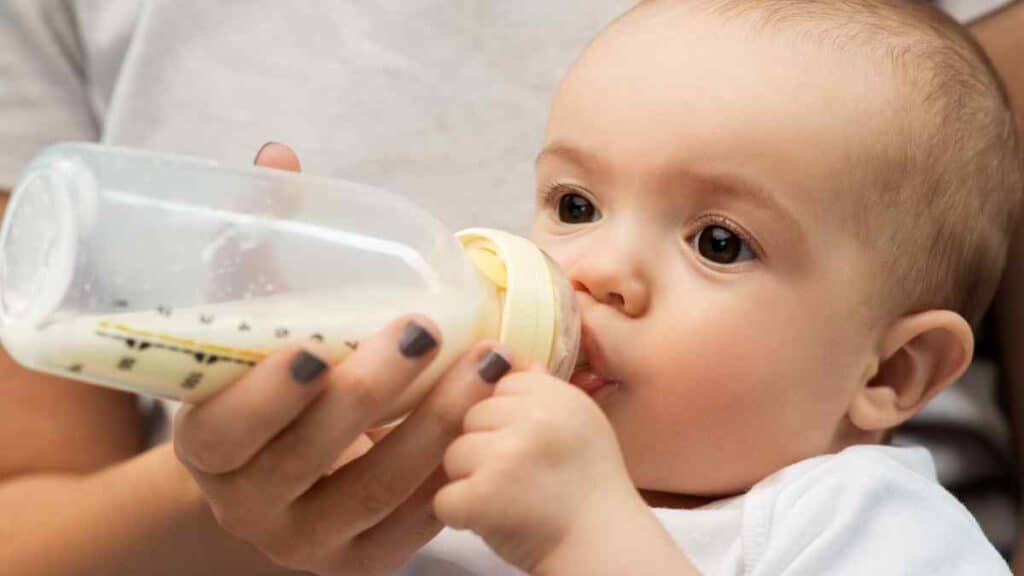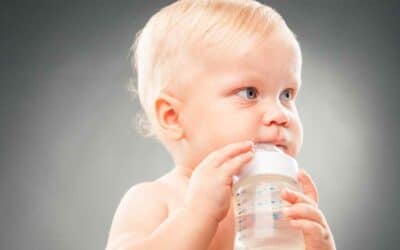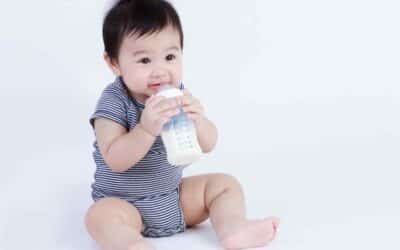In an age where environmental concerns and health-conscious parenting intersect, the issue of microplastics in baby bottles has become a matter of growing interest and concern. Welcome to our comprehensive exploration of this complex topic: “Tiny Trouble: Uncovering the Microplastic Mystery in Baby Bottles.”
Join us on this journey as we peel back the layers of the microplastic mystery in baby bottles, striving to understand better this tiny trouble and how we can protect our infants’ health and the environment for generations to come.

What Are Microplastics?
Microplastics have increasingly become a significant concern regarding environmental pollution. This post will discuss their definition, the familiar sources, and the potential concerns regarding human health and the environment.
Definition and Types
Microplastics are tiny plastic particles measuring less than five millimeters in length. This small debris can occur in various forms, including fragments, fibers, pellets, and films. These can be broadly divided into two categories:
Primary microplastics: These microplastics are intentionally designed to be small. They include exfoliating beads in cosmetics and industrial scrubbers used for abrasive blasting.
Secondary microplastics: These originate from the breakdown of more oversized plastic items, such as plastic containers and bags, through physical, biological, and chemical processes.
Sources and Common Uses
Microplastics come from a variety of sources, including plastics feeding bottles used in infant formula preparation. A study published by Trinity College Dublin in the journal Nature Food, revealed that heating polypropylene baby bottles releasing up to 16.2 million microplastic particles per liter. However, these findings by no means should unduly alarm parents, as the impact of such particles on human health is currently unclear, and further research is ongoing.
Other forms of microplastics result from more extensive plastic debris breakdown in the environment over time due to sun exposure, waves, and marine life. This includes plastic bags, bottles, and packaging in our oceans and waterways. Although, it’s suggested to prepare infant formula in a glass container to avoid potential microplastic particles exposure.
Environmental and Health Concerns
Microplastics pose significant environmental and health concerns.
- Environmental Impact: These tiny plastics are prevalent in our oceans and can be ingested by marine life, from microscopic plankton to large mammals. This leads to physical harm, exposure to harmful chemicals and pollutants, and even death. Additionally, microplastics can serve as transport mediums for invasive species and pollution.
- Human Health Impact: Despite being a relatively new area of study, there are concerns that microplastics, such as the ones potentially present in polypropylene plastic, may also impact human health. Our diet (mainly seafood), drinking water, and air can expose us to microplastics. Though our bodies usually excrete them, there’s still ongoing research to determine whether microplastics can cross biological barriers and cause harm.
Further research is essential to fully understand the impact of microplastics on the environment and human health. Yet, the findings until now indicate a need for changes in behavior and policy regarding plastic use and disposal.

The Baby Bottle Connection
The use of plastic in baby bottles has been a subject of concern due to potential health risks associated with microplastics and chemical leaching. This section will discuss the plastic predicament, infant health risks, and baby bottle brands’ prevalence.
The Plastic Predicament
Plastic baby bottles, particularly polypropylene, can release microplastics when exposed to high temperatures. This can happen during routine actions such as sterilization and warming the milk. These microplastics can leach into the milk, leading to infant ingestion.
Risks to Infant Health
Although the potential long-term effects of microplastics ingestion on infant health are not yet fully understood, some risks may include:
- Exposure to harmful chemicals: Most microplastics contain chemical additives, such as phthalates and bisphenol A (BPA), which may have health effects such as hormone disruption. They may also absorb pollutants from the environment, leading to the ingestion of additional contaminants.
- Inflammation: Microplastics can enter the bloodstream, leading to an inflammatory response in the immune system due to the foreign nature of the particles. Although this is not yet proven, such a response could result in various health issues in the long term.
However, more research is needed to establish the extent of these risks and better understand the effects of long-term microplastic exposure on human health.
How Microplastics Enter Baby Bottles
Microplastics find their way into baby bottles through several routes, including manufacturing, material composition, storage conditions, temperature effects, and daily feeding practices. This section delves into each of these categories.
Manufacturing and Material Composition
Plastic baby bottles are typically manufactured from materials like polypropylene, which can degrade under certain conditions to form microplastics. During the manufacturing process, tiny fragments of plastic may break off and remain on the surface of the bottles or become ingrained within them.
Storage and Temperature Effects
Microplastics can also enter baby bottles after the manufacturing process. High temperatures, especially during cleaning, sterilizing, or warming up the milk, can cause the plastic material to degrade and shed microplastics into the bottle. The same effect can occur due to prolonged UV exposure or radical temperature changes, affecting the bottle during transportation or storage.
Feeding Practices and Baby Bottle Use
Daily feeding practices can also contribute to the problem of microplastics in baby bottles. Heating the bottle, shaking the baby formula, or even scrubbing the bottle when cleaning can all cause the release of microplastics. Over time, continuous use and wear and tear can lead to increased microplastic shedding.

Impact on Infant Health
The potential impact caused by the ingestion of microplastics is a significant topic of concern when it comes to infant health. This section will list potential health risks, discuss the latest research findings, and share pediatrician recommendations.
Potential Health Risks
While research is still emerging in this area, potential health risks linked to microplastics exposure could include:
- Hormone disruption: Many microplastics contain and can leach chemicals like phthalates and bisphenol A (BPA), which are known endocrine disruptors. This implies that they can interfere with the endocrine system functioning, which might impact infant growth and development.
- Inflammation and immune response: Ingested microplastics can potentially lead to inflammation or immune reactions in the body, although the extent of such risks is still under scientific investigation.
- Toxicity risks: Microplastics can carry contaminants from the environment, leading to ingestion of additional toxins.
Studies and Research Findings
The World Health Organization (WHO) in 2019 reported that the extent of the risk presented by microplastics to human health is still a developing area of research. One of the most comprehensive studies in this field in 2020 estimated that infants fed with plastic bottles could ingest up to 16 million microplastics per liter of formula.
While these numbers may sound alarming, the health implications are still unclear as research is ongoing to understand the long-term effects of microplastic ingestion.
Pediatrician Recommendations
Without extensive scientific data, many pediatricians recommend a precautionary approach to minimize microplastic exposure.
- Use alternative materials: Parents can consider using glass or stainless steel baby bottles.
- Avoid heating in plastic: Parents should avoid heating bottles in the microwave and should consider heating the milk in a non-plastic container before transferring it to the bottle.
- Cleaning practices: Use warm, soapy water to clean the bottles and ensure they are thoroughly rinsed.
- Replace worn-out bottles: Ratched or damaged plastic bottles have a higher chance of releasing microplastics, so they should be replaced regularly.
As we await further research on this issue, these recommendations guide parents concerned about microplastic exposure.

Identifying Microplastics in Baby Bottles
Detecting the presence of microplastics in baby bottles can be challenging, especially for the untrained eye. However, you can employ a few methods to help identify likely sources of microplastics.
DIY Tests and Home Methods
Detecting microplastics at home can be difficult due to their small size. However, some signs might point to the existence of microplastics:
- Visual inspection: If a plastic bottle shows apparent deterioration, such as scratching, clouding, or chipping, there is a higher likelihood of microplastics.
- Temperature reaction: If the bottle changes shape, color or texture after being heated or cooled, it might release microplastics.
Remember that these home methods will not conclusively confirm the presence of microplastics, as they can be too small to see or identify without special equipment.
Third-Party Lab Testing
For a precise and definitive answer, third-party laboratory testing is required. Specialized labs use high-magnification microscopes and infrared spectroscopy to identify and quantify microplastics. This kind of testing, however, comes with a considerable cost and may need to be more practical for everyday household items like baby bottles.
Manufacturer Transparency
A more practical approach to avoiding microplastics might be to rely on manufacturers committed to transparency and ethical practices. Companies that voluntarily test their products for contaminants, including microplastics, and publish those results can provide a level of assurance regarding microplastics. Some manufacturers also provide information about the type of plastics used in their products and the steps taken to minimize microplastics.
Remember, the goal is to reduce microplastic exposure, not to eliminate it, as that would be practically impossible. Choosing baby bottles made from safer materials, following best practices for bottle use, and trusting transparent manufacturers are good strategies for mitigating microplastic risks.
Minimizing Microplastic Exposure
Reducing microplastic exposure in infants is essential until more definitive research is available. Here are some strategies for minimizing exposure.
Choosing Safe Baby Bottle Materials
One straightforward measure is to choose baby bottles made from safer materials. Here are some alternatives:
- Glass Bottles: Glass baby bottles are durable, non-porous, and free from harmful chemicals. They do not decay or degrade and are generally easier to clean.
- Stainless Steel Bottles: Stainless steel is another excellent option. It does not leach chemicals, is practically impossible to break, and keeps contents warm or cool for extended periods.
- BPA-free Plastic Bottles: If you must use plastic, opt for BPA and phthalate-free bottles. Polyether sulfone (PES) and polyphenyl sulfone (PPSU) bottles are often considered safer plastic alternatives.
Proper Cleaning and Care
How baby bottles are cleaned and cared for can also affect the release of microplastics:
- Avoiding Heat: Avoid sterilizing plastic bottles in boiling water or warming milk within them to prevent the plastic from degrading. However, Glass and stainless steel bottles can be safely sterilized with heat.
- Handwashing: Handwash plastic bottles in warm (not hot) soapy water and rinse them well.
- Avoiding Dishwashers: Avoid cleaning plastic baby bottles in the dishwasher as the high temperatures can increase microplastic release.
- Regular Replacement: Replace plastic bottles that are scratched, cloudy, or damaged as they are more likely to release microplastics.
Alternative Feeding Options
Another way to mitigate microplastic exposure is to consider alternative feeding options:
- Breastfeeding: Experts agree that breastfeeding is the ideal way of feeding an infant, as it is natural and free from any risk of microplastics. It also provides immunity benefits and encourages bonding.
- Spoon-feeding: Spoon-feeding can be an excellent way to reduce bottle usage for older infants taking semi-solid foods.
By choosing safer materials, taking good care of your bottles, and exploring alternative feeding options, you can significantly reduce your child’s exposure to microplastics.

The Transition: When Should Babies Switch to Cups with Straws?
One way to prevent microplastic exposure from baby bottles is to transition babies to using cups with straws. Here’s a guide on when and how this should be done.
Developmental Milestones
Around the baby’s first birthday is typically a good time to start introducing a cup with a straw. At this age, most babies are developmentally ready to begin learning how to drink from a straw, which can help them develop their oral motor skills.
Signs of Readiness
Babies show different signs that they are ready to start using a cup and straw, such as:
- Interest in your cup: If your baby shows interest when you’re drinking from a cup, it might signal readiness.
- Improved coordination: If your baby has started to pick up and handle objects well, these motor skills can be applied to hold a cup and straw.
- Ability to sit up and eat: Babies who can comfortably sit up and start eating other foods are often ready to use a cup.
Tips for a Smooth Transition
Transitioning babies to cups with straws may pose some challenges, but here are some tips to make the process smoother:
- Buy the right cup: Start with a suitable straw cup. Typically, it’s best to start with a ‘sippy cup,’ a spill-proof cup that allows them to suck rather than pour.
- Start with small amounts: Pour a small amount of milk or water into the cup to minimize spills.
- Demonstrate and encourage: Show your baby how to drink from a straw. Encourage them and make it a fun experience, and remember to be patient if they’re not interested the first time. Try again later.
- Gradual progress: Start by offering the cup during meals and gradually increase its use. Eventually, you can completely replace the bottle with the cup.
Remember that every child is unique and may transition at their own pace. Consult with your pediatrician to ensure your baby is developing healthily and if there are concerns about their feeding practices.

Conclusion
In conclusion, microplastics in plastic feeding bottles have become a growing concern as understanding their potential impact on the environment and human health continues to develop. As parents navigate this complex issue, making informed choices about the material, cleaning, and maintenance of baby bottles to minimize exposure to microplastics is essential.
Glass, stainless steel, high-quality plastic alternatives, and proper care and feeding practices can help reduce the risk of microplastic contamination. Furthermore, transitioning infants to cups with straws when developmentally appropriate can help limit the reliance on baby bottles.
Ultimately, continued research and advocacy for better policy and manufacturing practices regarding plastics are necessary to protect our infants’ health and the environment in which they will grow and thrive. By staying informed, adopting best practices, and supporting initiatives to reduce plastic waste, parents can play a crucial role in addressing the microplastic mystery in baby bottles and contribute to a healthier future for future generations.
Did this article help you? Please feel free to comment down below and let us know what you think. If you have any questions, don’t hesitate to ask!



